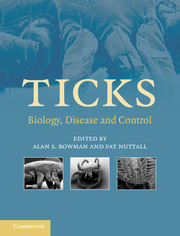Book contents
- Frontmatter
- Contents
- List of contributors
- Preface
- 1 Systematics and evolution of ticks with a list of valid genus and species names
- 2 The impact of tick ecology on pathogen transmission dynamics
- 3 Tick salivary glands: the physiology of tick water balance and their role in pathogen trafficking and transmission
- 4 Tick saliva: from pharmacology and biochemistry to transcriptome analysis and functional genomics
- 5 Tick toxins: perspectives on paralysis and other forms of toxicoses caused by ticks
- 6 Tick lectins and fibrinogen-related proteins
- 7 Endocrinology of tick development and reproduction
- 8 Factors that determine sperm precedence in ticks, spiders and insects: a comparative study
- 9 Tick immunobiology
- 10 Saliva-assisted transmission of tick-borne pathogens
- 11 Lyme borreliosis in Europe and North America
- 12 Viruses transmitted by ticks
- 13 Babesiosis of cattle
- 14 Theileria: life cycle stages associated with the ixodid tick vector
- 15 Characterization of the tick–pathogen–host interface of the tick-borne rickettsia Anaplasma marginale
- 16 Emerging and emergent tick-borne infections
- 17 Analysing and predicting the occurrence of ticks and tick-borne diseases using GIS
- 18 Acaricides for controlling ticks on cattle and the problem of acaricide resistance
- 19 Anti-tick vaccines
- 20 Anti-tick biological control agents: assessment and future perspectives
- 21 Pheromones and other semiochemicals of ticks and their use in tick control
- Index
- References
10 - Saliva-assisted transmission of tick-borne pathogens
Published online by Cambridge University Press: 21 August 2009
- Frontmatter
- Contents
- List of contributors
- Preface
- 1 Systematics and evolution of ticks with a list of valid genus and species names
- 2 The impact of tick ecology on pathogen transmission dynamics
- 3 Tick salivary glands: the physiology of tick water balance and their role in pathogen trafficking and transmission
- 4 Tick saliva: from pharmacology and biochemistry to transcriptome analysis and functional genomics
- 5 Tick toxins: perspectives on paralysis and other forms of toxicoses caused by ticks
- 6 Tick lectins and fibrinogen-related proteins
- 7 Endocrinology of tick development and reproduction
- 8 Factors that determine sperm precedence in ticks, spiders and insects: a comparative study
- 9 Tick immunobiology
- 10 Saliva-assisted transmission of tick-borne pathogens
- 11 Lyme borreliosis in Europe and North America
- 12 Viruses transmitted by ticks
- 13 Babesiosis of cattle
- 14 Theileria: life cycle stages associated with the ixodid tick vector
- 15 Characterization of the tick–pathogen–host interface of the tick-borne rickettsia Anaplasma marginale
- 16 Emerging and emergent tick-borne infections
- 17 Analysing and predicting the occurrence of ticks and tick-borne diseases using GIS
- 18 Acaricides for controlling ticks on cattle and the problem of acaricide resistance
- 19 Anti-tick vaccines
- 20 Anti-tick biological control agents: assessment and future perspectives
- 21 Pheromones and other semiochemicals of ticks and their use in tick control
- Index
- References
Summary
INTRODUCTION
Saliva-assisted transmission (SAT) is the indirect promotion of arthropod-borne pathogen transmission via the actions of arthropod saliva molecules on the vertebrate host. This phenomenon has been reported for most blood-feeding arthropods that transmit disease causing agents via their saliva, but the greatest number of examples has been recorded in ticks. The skin site where ticks feed is highly modified by the pharmacologically active molecules secreted in tick saliva. For pathogens, it is an ecologically privileged niche they can exploit. Here we review evidence for SAT and consider candidates for SAT factors among the tick pharmacopoeia of antihaemostatic, anti-inflammatory and immunomodulatory molecules. SAT factors appear to differ for different pathogens and tick vector species, and possibly even depend on the vertebrate host species on which a tick feeds. Most probably, SAT is mediated by a suite of molecules that act together to overcome the redundancy in host response mechanisms. The quest to identify the tick molecules that mediate SAT is an exciting one, offering new insights into host inflammatory and immune mechanisms, and novel ways of controlling ticks and tick-borne diseases.
TICK–HOST–PATHOGEN INTERACTIONS
The relationships between tick-borne pathogens, their tick vectors and diverse vertebrate hosts, can be represented by a triangle of parasitic interactions (Fig. 10). The interactions are between (i) pathogen–tick, (ii) pathogen–host and (iii) tick–host. In (i) the pathogen interacts with its vector, infecting and replicating within tick cells or extracellular spaces (including those of the gut, haemocoel and salivary glands).
- Type
- Chapter
- Information
- TicksBiology, Disease and Control, pp. 205 - 219Publisher: Cambridge University PressPrint publication year: 2008
References
- 35
- Cited by



